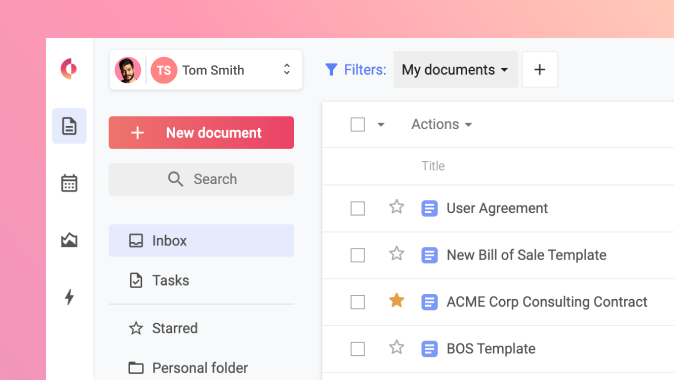Risk Assessment in Contract Management 101
The fact is, contracts are the heart of how your business mitigates risk and increases growth. Using the right processes and risk assessment will help protect you—and your organization from liability.
Contracts serve multiple functions. They’re also the DNA of a company—vital to the success and growth of every type of business.
Don’t get stuck with unnecessary risk. Whether it’s in the drafting, or negotiation process, mitigate problems with these best practices.
Risk Management Best Practice #1: Create Transparency
First of all, lack of transparency is a recipe for errors. This could be anything from frustrating scope creep, and revenue loss, to contract clause errors, and increase costs.
Errors are never deliberate, but deliberately eschewing a system that allows you more transparency is a mistake. The errors then become burdens that cause unnecessary lag and disruption to your business processes.
Unfortunately, contract errors are difficult to enforce, difficult to fix, and can end in canceling a crucial contract altogether.
Specifically, remember that:
- Transparency means that you replace vague language with more specific, agreed-upon language.
- Clear-up any misunderstanding in how you use terms by creating clear definitions of key terms.
- Identify every risk scenario and define it clearly for your business, and where the risk originates: whether as a point of regulatory compliance, or from a third-party.
Risk Management Best Practice #2: Review, and Review Again
Next, review begins with clarifying misunderstandings, and defining terms so that everyone’s on the same page.
However, it means creating a clear, audit-able trail of the negotiation process, too. You want to have a running summary from which you can test every area of a contact for accuracy and clarity.
Be sure to answer:
- Are rights and responsibilities clearly defined?
- Do you agree on the soundness of confidentiality terms?
- Are indemnity clauses clear and complete?
Then, be sure to clearly define, and review how and in what ways risk transfer is appropriated.
Risk Management Best Practice #3: Qualify Risk Transfer
Finally, this is a higher-stakes area in contract risk management and contract negotiation. When you consider risk transfer, you’re considering loss and how that loss is insured—not just for whom.
Harvard University advises to transfer risk in a number of ways:
- Financially – To offset all responsibilities, or to share this as a means to limiting revenue loss.
- Indemnity terms – Negotiate indemnity terms that hold you, and your business harmless from any legal consequences and that merit compensation.
- Liability terms – Conversely, guard your organization against risk with a sound wall of liability limits.
- Subrogation waivers – By and large, insurance is a main route to waiving subrogation rights in any loss. Closing any gaps in risk by increasing commercial insurance, adding riders, and naming third-parties is a must to support your contractual waiver terms.
Contract Lifecycle Management- Automate the Process to Decrease Risk
Concord is at the forefront of contract lifecycle management software. A CLM addresses the central issue of contract risk by engendering collaboration in the contract negotiation and management process.
Furthermore, this opens up channels of communication between colleagues, external stakeholders, and third parties.
Some of the key features that help optimize communication to reduce risk are:
- Versioning: In Concord, new versions of contracts are saved and displayed in chronological order next to the corresponding document. These records are permanent, and cannot be altered. Concord keeps all versions clearly marked and centrally stored. This feature allows all parties to quickly and easily see that they are working on the most up-to-date version. It also shows the evolution of past changes to the document.
- Discussion Panel: Concord’s discussion panel provides an in-platform messaging space. Building discussion into the contract platform itself eliminates the need for back-and-forth by email. With Concord, the discussion panel next to the contract for reference in contract terms discussions.
- Collaboration Across Teams: Look for a central hub through which colleagues can collaborate together to produce a document draft. Additionally, a single draft can be worked on easily in real-time, with accurate records of document versions and changes. After the draft is complete, it’s simple to invite external stakeholders to negotiate within the Concord platform.
- Approval Workflows: Concord allows each document to have its own Approval Workflow in order to ensure the appropriate team members are alerted to act at the appropriate juncture of the negotiation workflow. Clearly, this greatly simplifies the collaboration process. It helps by automating and mapping out the actions needed to approve a document.
- Clause Alerts: What’s more, users can configure clause alerts for specific events in the contract lifecycle. These might include advanced notice of termination and contract renewal dates. Concord will send automated alerts via email in advance of a clause deadline. This allows users to appropriately prepare needed actions. Alerts ensure that crucial actions will not be missed or forgotten about. Additionally, it keeps all parties involved and informed.
Contract Risk Mitigation through Software
Most importantly, eliminate back-and-forth contract management across different systems, and communicate in one single place. With a CLM, the entire contract processes can be simplified, reducing risk and increasing transparency.
Concord enables over 200,000 companies around the globe to connect all their people, processes, and contracts in one place. Built with intuitive features—like online negotiation and editing, deadline alerts, and approval workflows, Our CLM gives users everything they need for the entire contract lifecycle, making growth and compliance synonymous.



